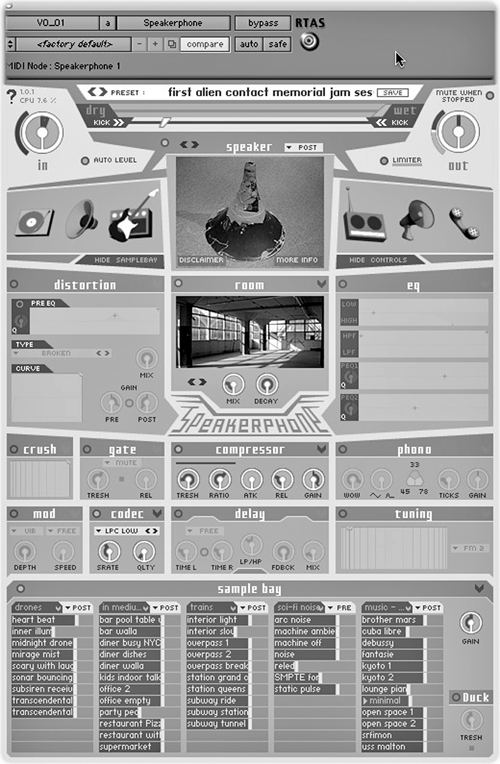by Steve Cunningham
Anyone who has been around production for a while knows how to create a phone filter using EQ; just roll off everything below 500 Hz and above 2.5 kHz, add a little distortion, and Bob's your uncle. Whether it's used simply for dramatic effect, to add realism to phone conversations in spots, or theatrically to indicate a character's inner thought process, the classic phone filter is perhaps one of the most-used effects in production. Or, as the Firesign Theater's Nick Danger would ask, "and ...how do I make my voice do this?"
Audio Ease, the folks who brought you one of the first pro-level convolution reverb processors, has tackled the simple phone filter and applied the same sophisticated convolution technology to emulating phones, radios, turntables, guitar cabinets, walkie-talkies, and almost anything else with a speaker. The result is Speakerphone, a plug-in that includes a speaker emulator, a convolution reverb, signal processing, and even some cool background effects samples. This ain't your father's phone filter -- even Bud Selig would recognize the juice that's used here. Let's take a look.

SETUP
Speakerphone is available as a plug-in for both Windows and Macintosh computers. It's available as a VST or Pro Tools RTAS plug on the Windows side, and as a VST, RTAS, Audio Unit, and MAS (for MOTU) on the Mac side. Since it's a serious convolution processor that requires some horsepower to perform its math, Speakerphone for Windows wants to see a Pentium 4 at 1.6 GHz as a minimum, and prefers an Intel Core2Duo at 2.0 GHz or better. For the Mac you can use a G4 at 1 GHz, but you'll be happier with a G5 or Intel Mac Pro. It also wants to see at least 512 MB of memory, but you'll want to have 2 GB to do any serious work. It runs under Windows XP SP2 and Vista (although I tested only on XP), and under Mac OSX 10.3.9 or better (it is not yet qualified for 10.5). You'll also need about 5 GB on your hard drive for the samples and impulse response files. As a plug in, Audio Ease has tested it with all flavors of Pro Tools, along with Nuendo, Cubase, Samplitude, Logic Pro, and Sonar. Check the website to see if your preferred editor is supported.
Speakerphone is copy protected with either an iLok USB dongle, or by a challenge/response serial number system. I opted for the iLok and recommend it, since it's reasonably trouble-free and allows you to install the plug on multiple computers (you just have to plug your iLok into the one you're actually using). The installation process includes authorization via the Internet for both options, and the procedure is painless. What isn't entirely painless is the wait time while the installer copies all the impulse response files to your hard drive; this can take ten or fifteen minutes. Just be patient... it'll get there.
Once it's finished, you're free to fire up an editor and go to work.
You can instantiate Speakerphone on an insert or on a bus, depending on your workflow and what you want processed. In either case you will notice a CPU hit of between 10 and 30%, even when no audio is playing. Told you it was serious.

